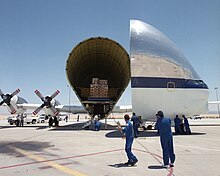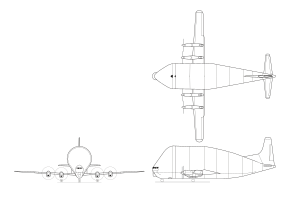Aero Spacelines Super Guppy
| B-377-SG/SGT Super Guppy | |
|---|---|

| |
| A Super Guppy Turbo used by NASA | |
| Role | Outsize cargo freight aircraft |
| Manufacturer | Aero Spacelines |
| First flight | August 31, 1965[1] |
| Status | Airworthy |
| Primary users | Aero Spacelines[1] NASA[1] Airbus[1] Aeromaritime[1] |
| Number built | 1 SG, 4 SGT[1] |
| Developed from | C-97J Turbo Stratocruiser[1] 377 Stratocruiser[2] Pregnant Guppy (fourth one built with cannibalized pieces from Pregnant Guppy) |
The Aero Spacelines Super Guppy is a large, wide-bodied cargo aircraft that is used for hauling outsized cargo components. It was the successor to the Pregnant Guppy, the first of the Guppy aircraft produced by Aero Spacelines. Five were built in two variants, both of which were colloquially referred to as the "Super Guppy".
Design and development
The first, the Super Guppy, or "SG", was built directly from the fuselage of a C-97J Turbo Stratocruiser, the military version of the 1950s Boeing 377 "Stratocruiser" passenger plane. The fuselage was lengthened to 141 feet (43 m), and ballooned out to a maximum inside diameter of 25 ft (7.6 m), the length of the cargo compartment being 94 ft 6 in (28.8 m). The floor of the cargo compartment was still only 8 ft 9 in (2.7 m) wide, as necessitated by the use of the Stratocruiser fuselage.[1]
In addition to the fuselage modifications, the Super Guppy used Pratt & Whitney T-34-P-7 turboprop engines for increased power and range, and modified wing and tail surfaces. It could carry a load of 54,000 pounds (24,545 kg) and cruise at 300 mph (480 km/h).

The second version was officially known as the Super Guppy Turbine (SGT), although it used turboprop engines like the first Super Guppy. This variant used Allison 501-D22C turboprops. Unlike previous Guppies, the main portion of its fuselage was constructed from scratch. By building from scratch, Aero Spacelines was able to widen the floor of the cargo compartment to 13 ft (4 m). The overall cargo compartment length was increased to 111 ft (33.8 m), and the improved fuselage and engines allowed for a maximum load of 54,500 pounds (24,700 kg). These design improvements, combined with a pressurized crew cabin that allowed for higher-altitude cruising, allowed the SGT to transport more cargo than its predecessors.[1]
The SGT retained only the cockpit, wings, tail, and main landing gear of the 377. The nose gear was taken from the Boeing 707 – and reversed 180 degrees. This dropped the front of the aircraft slightly, leveling the cargo bay floor and simplifying loading operations.

In the early 1970s, the two Super Guppies were used by Airbus to transport aeroplane parts from decentralised production facilities to the final assembly plant in Toulouse. In 1982 and 1983, two additional Super Guppies were built by UTA Industries in France after Airbus bought the right to produce the aircraft. The four Super Guppies have since been replaced by the Airbus Beluga, capable of carrying twice as much cargo—by weight, though not nearly as much as a C-5 Galaxy or an Antonov-124 (47 tons as compared to 122.5 and 150 tons, respectively).[citation needed]
The last produced Super Guppy remains in service: an SGT flown by NASA (currently used to ferry components for the International Space Station and Project Orion). It is stationed in and operated from Ellington Field in Houston, Texas.[3] The other four are mothballed; the SG at Pima Air and Space Museum, Davis-Monthan Air Force Base, Arizona, United States, the first SGT, which has recently begun a restoration project, at Bruntingthorpe Aerodrome, United Kingdom, the second outside Airbus' factories at Toulouse Blagnac International Airport, Toulouse, France, and the third at Finkenwerder, Germany.
Variants
- Aero Spacelines B-377-SG Super Guppy – Prototype of a much enlarged version of the guppy using C-97J components, powered by four Pratt & Whitney T-34-P-7WA turbo-prop engines.[1]
- Aero-Spacelines B-377-SGT Super Guppy Turbine (Guppy 201) – Production version powered by Allison 501-D22C turbo-prop engines,[1] using an enlarged cargo section built from scratch instead of being converted from original C-97J components.
Operators

Specifications (Super Guppy)

Data from Mondey, David Encyclopedia of The World's Commercial and Private Aircraft, p. 9 New York: Crescent Books (1981)
General characteristics
- Crew: FourCargo bay dimensions: 111 ft × 25 ft × 25 ft (33.8 m × 7.62 m × 7.62 m)
Performance
See also

Related development
Aircraft of comparable role, configuration, and era
References
- ^ a b c d e f g h i j k Taylor, Michael JH (1989), Encyclopedia of Aviation, Jane's, London: Studio Editions, ISBN 0-517-69186-8
- ^ All About Guppies, retrieved 4/1/2011
{{citation}}: Check date values in:|accessdate=(help) - ^ "NASA - Super Guppy Makes Brief Appearence". Nasa.gov. 12 July 2012. Retrieved 31 August 2012.
- Taylor, Michael J.H. . Jane's Encyclopedia of Aviation. Studio Editions. London. 1989. ISBN 0-517-69186-8
External links
- NASA Super Guppy website
- Johnson Space Center's Super Guppy website
- Boeing B-377 history website
- "All About Guppys" - Historical information website about the Guppy aircraft
- Super Guppy Restoration Project - Website for the F-BTGV restoration project
